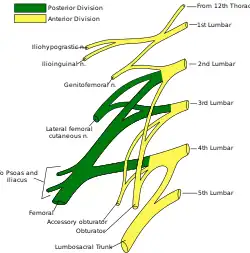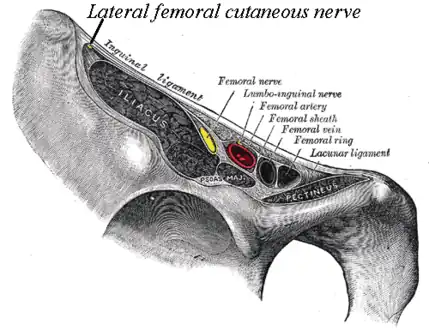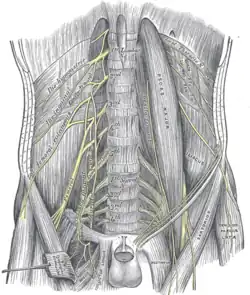Lateral cutaneous nerve of thigh
| Lateral cutaneous nerve of thigh | |
|---|---|
 Plan of lumbar plexus. (Lateral femoral cutaneous visible at left.) | |
 Cutaneous nerves of the right lower extremity. Front and posterior views. | |
| Details | |
| From | lumbar plexus (L2–L3) |
| Innervates | Skin on the lateral part of the thigh |
| Identifiers | |
| Latin | nervus cutaneus femoris lateralis |
| TA98 | A14.2.07.011 |
| TA2 | 6521 |
| FMA | 16485 |
| Anatomical terms of neuroanatomy | |
The lateral cutaneous nerve of the thigh (also called the lateral femoral cutaneous nerve) is a cutaneous nerve of the thigh. It originates from the dorsal divisions of the second and third lumbar nerves from the lumbar plexus. It passes under the inguinal ligament to reach the thigh. It supplies the skin on the lateral part of the thigh. Nerve compression can cause meralgia paraesthetica.
Structure
The lateral cutaneous nerve of the thigh is a nerve of the lumbar plexus.[1] It arises from the dorsal divisions of the second and third lumbar nerves (L2-L3).[1] It emerges from the lateral border of the psoas major muscle at about its middle. It crosses the iliacus muscle obliquely, toward the anterior superior iliac spine (ASIS). It then passes under the inguinal ligament.[1] It passes through the muscular lacuna, and then over the sartorius muscle into the thigh. It divides into an anterior and a posterior branch.
The anterior branch becomes superficial about 10 cm below the inguinal ligament, and divides into branches which are distributed to the skin of the anterior and lateral parts of the thigh, as far as the knee. The terminal filaments of this nerve frequently communicate with the anterior cutaneous branches of the femoral nerve, and with the infrapatellar branch of the saphenous nerve, forming with them the peripatellar plexus.
The posterior branch pierces the fascia lata, and subdivides into filaments which pass backward across the lateral and posterior surfaces of the thigh, supplying the skin from the level of the greater trochanter to the middle of the thigh.
Function
The lateral cutaneous nerve of the thigh is a sensory nerve.[1] It supplies the skin on the lateral (outer) part of the thigh.[1]
Clinical significant
Entrapment of the lateral cutaneous nerve of the thigh is caused by compression of the nerve near the anterior superior iliac spine and the inguinal ligament.[1] This causes meralgia paraesthetica (Bernhardt-Roth syndrome).[1][2]
Additional images
 Lateral cutaneous nerve of thigh and other structures passing behind the inguinal ligament
Lateral cutaneous nerve of thigh and other structures passing behind the inguinal ligament The great saphenous vein and its tributaries at the fossa ovalis.
The great saphenous vein and its tributaries at the fossa ovalis. The lumbar plexus and its branches.
The lumbar plexus and its branches. Deep and superficial dissection of the lumbar plexus.
Deep and superficial dissection of the lumbar plexus. Diagram of segmental distribution of the lateral cutaneous nerve (shaded) and other nerves of the right leg. Front view.
Diagram of segmental distribution of the lateral cutaneous nerve (shaded) and other nerves of the right leg. Front view. Cutaneous nerves of the right lower extremity. Front and posterior views.
Cutaneous nerves of the right lower extremity. Front and posterior views.
See also
References
![]() This article incorporates text in the public domain from page 953 of the 20th edition of Gray's Anatomy (1918)
This article incorporates text in the public domain from page 953 of the 20th edition of Gray's Anatomy (1918)
- 1 2 3 4 5 6 7 David, W. S. (2014). "Meralgia Paresthetica". Encyclopedia of the Neurological Sciences - Reference Module in Neuroscience and Biobehavioral Psychology (2nd ed.). Academic Press. pp. 1099–1100. doi:10.1016/B978-0-12-385157-4.00666-7. ISBN 978-0-12-385158-1.
- ↑ Waldman, Steven D. (2009). "177 - Meralgia Paresthetica". Pain Review. Saunders. p. 301. doi:10.1016/B978-1-4160-5893-9.00177-5. ISBN 978-1-4160-5893-9.
External links
- Lateral_femoral_cutaneous_nerve at the Duke University Health System's Orthopedics program
- Anatomy photo:40:17-0201 at the SUNY Downstate Medical Center - "Posterior Abdominal Wall: Nerves of the Lumbar Plexus"
- posteriorabdomen at The Anatomy Lesson by Wesley Norman (Georgetown University) (posteriorabdmus&nerves)